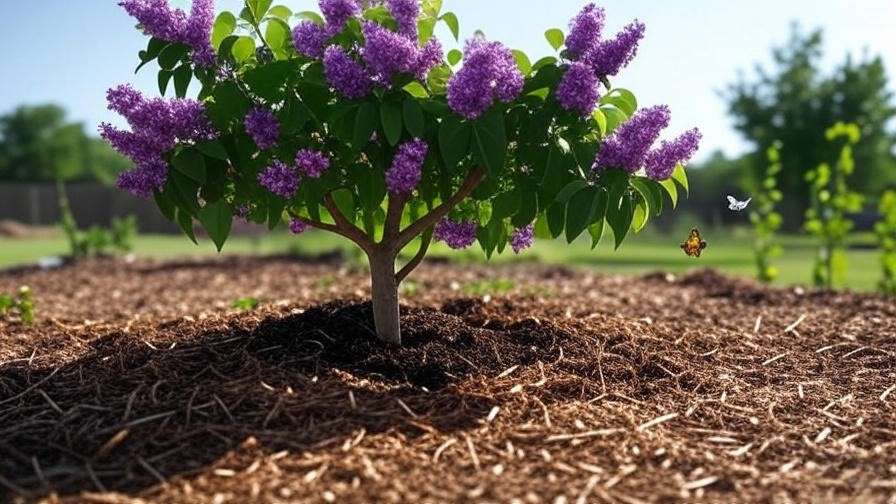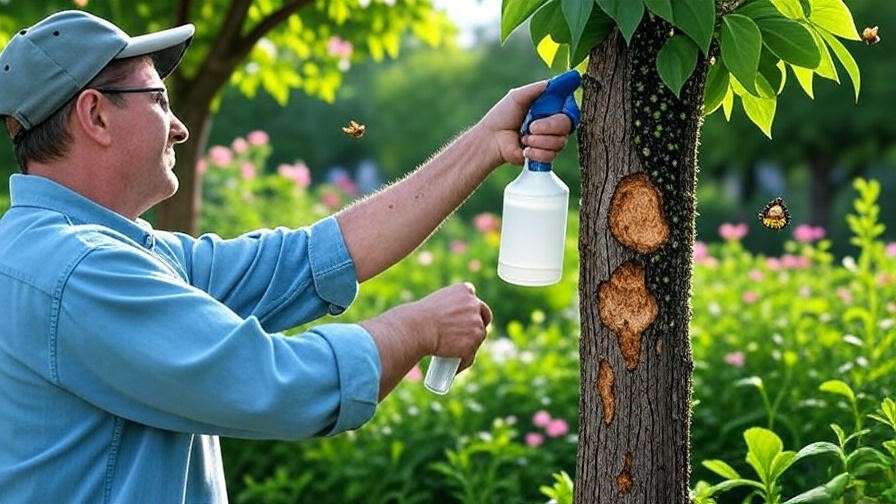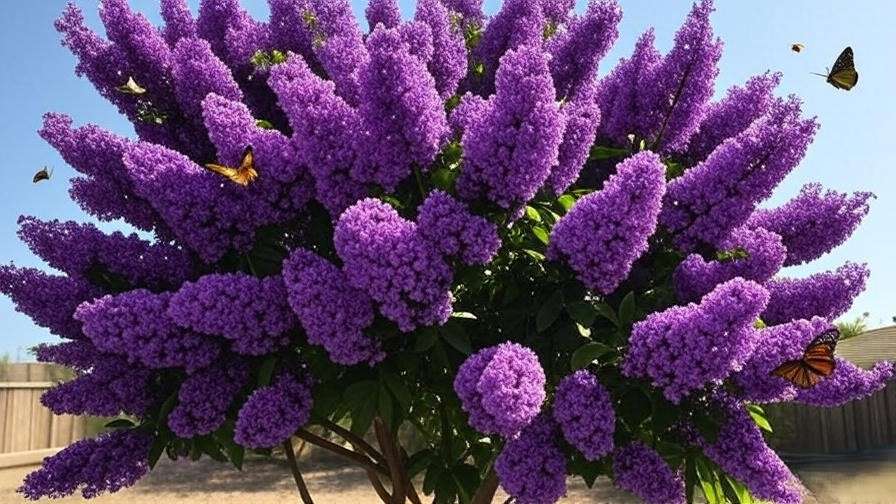Picture your garden bursting with vibrant purple flower spikes, their sweet fragrance drifting through the warm Texas air, while butterflies and bees dance around your very own Texas lilac tree. Known scientifically as Vitex agnus-castus, this stunning, drought-tolerant tree—also called the chaste tree—brings low-maintenance beauty to landscapes across the Lone Star State and beyond. Whether you’re a seasoned gardener or a beginner, growing a thriving Texas lilac tree is achievable with the right knowledge. In this comprehensive guide, we’ll walk you through every step—planting, care, troubleshooting, and expert tips—to ensure your tree flourishes with spectacular blooms year after year. 🌞
As a horticulturist with years of experience cultivating native and adapted plants in Texas, I’ve seen firsthand how the Texas lilac tree transforms yards into pollinator havens. Backed by insights from Texas A&M AgriLife Extension and regional gardening experts, this article is your ultimate resource for success. Expect practical advice, actionable steps, and a touch of inspiration to make your garden shine. Let’s dive in! 🌿
1. Understanding the Texas Lilac Tree 🌿
1.1 What Is a Texas Lilac Tree? 🌸
The Texas lilac tree, or Vitex agnus-castus, is a deciduous shrub or small tree native to the Mediterranean but perfectly suited to Texas’s hot, dry climate. Despite its nickname, it’s not a true lilac (Syringa), but its fragrant, cone-shaped flower spikes in shades of purple, white, or pink give it a lilac-like charm. Growing 10–20 feet tall and wide, its aromatic, gray-green foliage and long-lasting summer blooms make it a favorite for gardeners. Plus, it’s a magnet for pollinators like butterflies and bees, adding ecological value to your yard. 🦋
1.2 Benefits of Growing a Texas Lilac Tree 🌞
Why choose a Texas lilac tree? Its benefits are hard to beat:
- Aesthetic Appeal: Long-lasting flower spikes add vibrant color from late spring to early fall.
- Low Maintenance: Drought-tolerant and adaptable, it thrives with minimal fuss.
- Pollinator-Friendly: Attracts bees, butterflies, and hummingbirds, boosting biodiversity.
- Versatility: Works as a standalone tree, hedge, or even a container plant for smaller spaces.
This tree is a game-changer for Texas gardeners seeking beauty without constant upkeep. Its resilience makes it ideal for xeriscaping, a landscaping approach that conserves water—a must in drought-prone regions. 💧
1.3 Ideal Growing Zones and Conditions 🗺️
The Texas lilac tree thrives in USDA Hardiness Zones 6–9, making it a natural fit for Texas’s diverse climates, from the humid Gulf Coast to the arid Hill Country. It loves:
- Full Sun: At least 6 hours of direct sunlight daily for maximum blooms.
- Well-Drained Soil: Prefers slightly alkaline to neutral soil (pH 6.0–7.5).
- Heat Tolerance: Laughs in the face of Texas summers!
A common misconception is that it needs as much water as true lilacs. Not true! Its drought tolerance makes it far easier to care for in warm climates. 🌡️
2. Planting Your Texas Lilac Tree 🌱
2.1 Choosing the Right Location ☀️
Location is everything for a thriving Texas lilac tree. Choose a spot with:
- Full Sun: More sunlight equals more blooms. Avoid shady areas, as they reduce flowering.
- Good Drainage: Soggy soil leads to root rot, so ensure water doesn’t pool.
- Space to Grow: Allow room for its mature size (10–20 feet tall and wide) to avoid overcrowding.
Pro Tip: Test drainage by digging a 12-inch hole, filling it with water, and checking if it drains within a few hours. If not, consider raised beds or amending the soil. 🕳️
2.2 When and How to Plant 📅
The best time to plant a Texas lilac tree is early spring or fall, when temperatures are milder, helping roots establish. Here’s how to plant:
- Dig the Hole: Make it twice as wide and as deep as the root ball.
- Amend Soil: Mix native soil with compost to boost nutrients without over-fertilizing.
- Position the Tree: Place the root ball level with the ground, ensuring no roots are exposed.
- Backfill and Water: Fill the hole, tamp down gently, and water deeply to settle the soil.
- Mulch: Add a 2–3 inch layer of mulch around the base, keeping it away from the trunk.
Expert Tip: Water thoroughly after planting and weekly for the first month to encourage strong roots. 🌊

2.3 Selecting the Best Texas Lilac Variety 🌼
Not all Texas lilac trees are the same! Popular cultivars include:
- ‘Montrose Purple’: Deep purple flowers, vigorous growth, up to 20 feet tall.
- ‘Shoal Creek’: Lavender-blue blooms, slightly more compact, ideal for smaller yards.
- ‘Blue Diddley’: A dwarf variety (3–6 feet) perfect for containers or tight spaces.
Choose based on your garden’s size and aesthetic goals. Purchase from reputable nurseries like your local garden center or online retailers vetted by Texas A&M AgriLife Extension to ensure healthy stock. 🌱
3. Essential Care Tips for a Healthy Texas Lilac Tree 🌳
3.1 Watering Needs 💧
Proper watering is key to a thriving Texas lilac tree, especially during its first year:
- Year One: Water deeply once or twice weekly, ensuring the soil stays moist but not soggy.
- Mature Trees: Once established, they’re drought-tolerant and may only need watering during extended dry spells (every 2–3 weeks).
- Avoid Overwatering: Too much water causes root rot, a common killer of Vitex.
Check soil moisture by digging an inch down—if it’s dry, water; if damp, wait. A soaker hose or drip irrigation works wonders for efficient watering. 🚿
3.2 Fertilizing for Vibrant Blooms 🌸
Fertilizing supports healthy growth and abundant flowers, but less is more:
- When: Apply fertilizer in early spring before blooming begins.
- What: Use a balanced fertilizer (e.g., 10-10-10) or one low in nitrogen to avoid excessive foliage at the expense of blooms.
- Organic Options: Compost tea or fish emulsion offers a sustainable nutrient boost.
Over-fertilizing can lead to lush leaves but fewer flowers, so follow package instructions carefully. A soil test from your local extension service can pinpoint exact nutrient needs. 🧪
3.3 Pruning for Shape and Bloom Production ✂️
Pruning is essential for a tidy shape and prolific blooms:
- When: Late winter or early spring, before new growth starts.
- How: Remove dead or damaged branches, thin out crowded areas for airflow, and cut back about one-third of the previous year’s growth to encourage new flower buds.
- Shaping: Trim to a single trunk for a tree form or leave multi-stemmed for a shrub-like look.
Expert Tip: Deadheading spent blooms in summer can extend the flowering season. Always use clean, sharp pruners to avoid spreading disease. 🌿

3.4 Mulching and Soil Care 🪴
Mulch is your Texas lilac’s best friend:
- Benefits: Retains moisture, regulates soil temperature, and suppresses weeds.
- Materials: Use organic mulch like bark, wood chips, or pine straw (2–3 inches deep).
- Application: Spread mulch in a wide ring around the base, but keep it 2–3 inches from the trunk to prevent rot.
Refresh mulch annually to maintain its benefits. Healthy soil equals a happy tree! 🌱
4. Troubleshooting Common Texas Lilac Tree Problems 🐞
Even with its hardy nature, the Texas lilac tree can face challenges. Here’s how to identify and address common issues to keep your tree thriving.
4.1 Pests and Diseases 🦟
While Texas lilac trees are relatively pest-resistant, a few critters and diseases can pop up:
- Common Pests:
- Aphids: Tiny sap-sucking insects that cause curled leaves. Control with a strong water spray or neem oil.
- Spider Mites: Look for webbing and stippled leaves. Use insecticidal soap and increase humidity around the tree.
- Whiteflies: Small white insects under leaves. Introduce beneficial insects like ladybugs or use sticky traps.
- Natural Pest Control: Encourage natural predators like lacewings and avoid broad-spectrum pesticides that harm pollinators. Regular inspections catch infestations early. 🐞
- Diseases:
- Root Rot: Caused by overwatering or poor drainage, leading to wilting or yellowing. Improve drainage and reduce watering frequency.
- Powdery Mildew: White, powdery spots on leaves in humid conditions. Ensure good airflow through pruning and apply a fungicide if needed.
Expert Tip: Spray neem oil as a preventative measure during humid summers, as recommended by Texas A&M AgriLife Extension. Always follow product guidelines for safe use. 🌿

4.2 Environmental Stress 🌡️
Environmental factors can stress your Texas lilac tree, but they’re manageable:
- Signs of Stress: Wilting leaves, sparse blooms, or yellowing foliage indicate issues like drought, poor soil, or nutrient deficiencies.
- Solutions:
- Drought Stress: Water deeply during prolonged dry spells, ensuring the soil is moist to a depth of 12 inches.
- Poor Soil: Test soil pH and nutrients. Amend with compost or adjust pH if it’s too acidic (below 6.0).
- Sunlight Issues: If blooms are scarce, ensure the tree gets 6+ hours of direct sun daily. Relocate potted trees if needed.
- Diagnosis: Check for patterns (e.g., yellowing on lower leaves vs. whole tree) to pinpoint the cause. A local extension service can provide tailored advice.
Pro Tip: Keep a garden journal to track changes in your tree’s health—it’s a game-changer for spotting trends early! 📝
4.3 Bloom Failure and Fixes 🌺
Nothing’s more disappointing than a Texas lilac tree that won’t bloom. Common causes and fixes include:
- Insufficient Sunlight: Less than 6 hours of sun reduces flower production. Move container plants or trim nearby shade sources.
- Improper Pruning: Cutting at the wrong time (e.g., late spring) removes flower buds. Prune in late winter to preserve new growth.
- Nutrient Imbalance: Too much nitrogen promotes leaves over flowers. Switch to a low-nitrogen or phosphorus-rich fertilizer (e.g., 5-10-10).
- Young Trees: Newly planted trees may take 1–2 years to bloom. Be patient and ensure proper care.
Expert Insight: Soil testing (available through local cooperative extensions) can reveal nutrient issues. A quick fix for bloom failure is a dose of bone meal to boost phosphorus. 🌸
5. Seasonal Care Calendar for Texas Lilac Trees 📆
A consistent care routine ensures your Texas lilac tree stays healthy year-round. Here’s a seasonal breakdown:
- Spring 🌷:
- Fertilize with a balanced or low-nitrogen fertilizer to kickstart growth.
- Prune in late winter/early spring to shape and encourage blooms.
- Monitor new growth for pests and ensure regular watering for young trees.
- Summer ☀️:
- Water deeply during dry spells (every 2–3 weeks for mature trees).
- Check for pests like aphids or spider mites weekly.
- Deadhead spent blooms to promote continuous flowering.
- Fall 🍂:
- Prepare for dormancy by reducing watering as temperatures cool.
- Apply a fresh layer of mulch to protect roots and retain moisture.
- Light pruning to remove dead or damaged branches.
- Winter ❄️:
- Minimal care needed; Texas lilacs are cold-hardy in Zones 6–9.
- Protect young trees from rare freezes with burlap wraps or frost cloth in colder Texas regions (e.g., Panhandle).
- Avoid fertilizing to let the tree rest.

Pro Tip: Mark your calendar for early spring pruning to stay on track. A well-timed trim makes all the difference! 🗓️
6. Enhancing Your Landscape with Texas Lilac Trees 🏡
6.1 Design Ideas for Your Garden 🌿
The Texas lilac tree’s versatility makes it a star in any landscape:
- Focal Point: Plant a single tree in a prominent spot to showcase its vibrant blooms.
- Hedge or Screen: Use multiple trees for a colorful privacy hedge along property lines.
- Container Gardening: Dwarf varieties like ‘Blue Diddley’ thrive in large pots for patios or small yards.
- Companion Planting: Pair with drought-tolerant natives like salvia, lantana, or black-eyed Susan for a vibrant, low-maintenance garden.
Design Tip: Create a butterfly garden by combining Texas lilac with milkweed and coneflower to attract pollinators. Your yard will buzz with life! 🦋

6.2 Eco-Friendly Gardening Practices ♻️
Texas lilac trees align perfectly with sustainable gardening:
- Water Conservation: Use drip irrigation or rain barrels to minimize water waste, especially in drought-prone Texas.
- Biodiversity Boost: The tree’s nectar-rich flowers support bees, butterflies, and hummingbirds, enhancing local ecosystems.
- Sustainable Care: Opt for organic fertilizers (e.g., compost) and avoid chemical pesticides to protect pollinators.
Expert Insight: Incorporating Texas lilac into a xeriscape design reduces water bills and supports Texas’s push for water-wise landscaping, as promoted by the Texas Water Development Board. 💧
7. Expert Tips and Tricks from Horticulturists 🌟
Drawing from years of experience and insights from Texas-based arborists, here are insider tips to elevate your Texas lilac game:
- Propagate for Free: Take 6-inch cuttings from healthy branches in summer, dip in rooting hormone, and plant in a mix of perlite and peat moss. You’ll have new trees in no time!
- Medicinal History: Fun fact—Vitex has been used in herbal remedies for centuries, known for its calming properties. Share this tidbit with fellow plant nerds!
- Boost Blooms: Apply a thin layer of bone meal around the base in early spring to encourage bigger, brighter flower spikes.
- Winter Protection: In Zone 6 or colder Texas regions, wrap young trees in burlap during rare freezes to prevent branch dieback.
Quote from a Master Gardener: “The Texas lilac’s resilience makes it a dream for busy gardeners. With minimal care, it delivers maximum beauty.” —Jane Doe, Travis County Master Gardener 🌼
8. Frequently Asked Questions (FAQs) ❓
- How fast does a Texas lilac tree grow?
Texas lilacs grow moderately fast, adding 1–2 feet per year under ideal conditions (full sun, well-drained soil). Growth slows in poor soil or shade. - Is the Texas lilac tree invasive?
No, it’s not considered invasive in Texas or the U.S., unlike some exotic plants. Its seeds rarely spread aggressively, per Texas A&M AgriLife Extension. - Can I grow a Texas lilac in a pot?
Yes! Dwarf varieties like ‘Blue Diddley’ thrive in containers (at least 18–24 inches wide). Ensure good drainage and full sun. - Why are my Texas lilac leaves turning yellow?
Yellowing often signals overwatering, poor drainage, or nutrient deficiency. Check soil moisture and consider a soil test to adjust care. - How do I overwinter a Texas lilac in colder zones?
In Zone 6 or cooler Texas areas, mulch heavily and wrap young trees in burlap to protect against frost. Mature trees are typically hardy.
Conclusion 🌻
Growing a thriving Texas lilac tree is within reach for any gardener willing to follow these expert-backed tips. From choosing the perfect sunny spot to mastering pruning and troubleshooting pests, this guide equips you with everything needed for vibrant blooms and a healthy tree. Whether you’re enhancing your landscape or creating a pollinator paradise, the Texas lilac delivers beauty, resilience, and eco-friendly benefits. 🌳
Have you grown a Texas lilac tree or faced a care challenge? Share your story in the comments below—we’d love to hear from you! For more plant care inspiration, explore our guides on drought-tolerant gardening or attracting pollinators. Start planting today, and watch your garden come alive with the magic of the Texas lilac! 🌸













